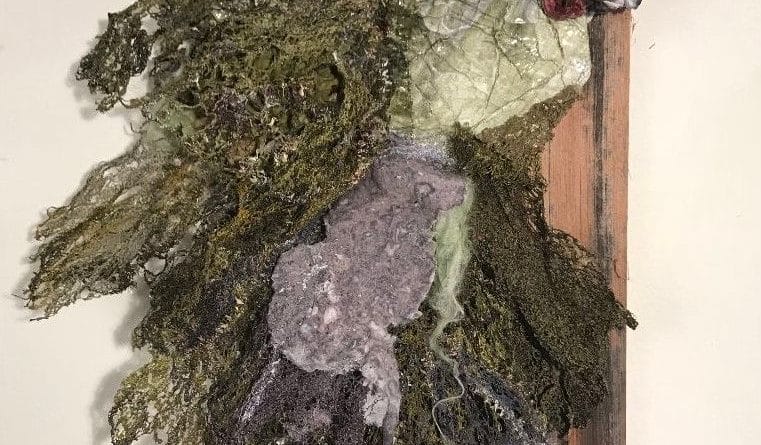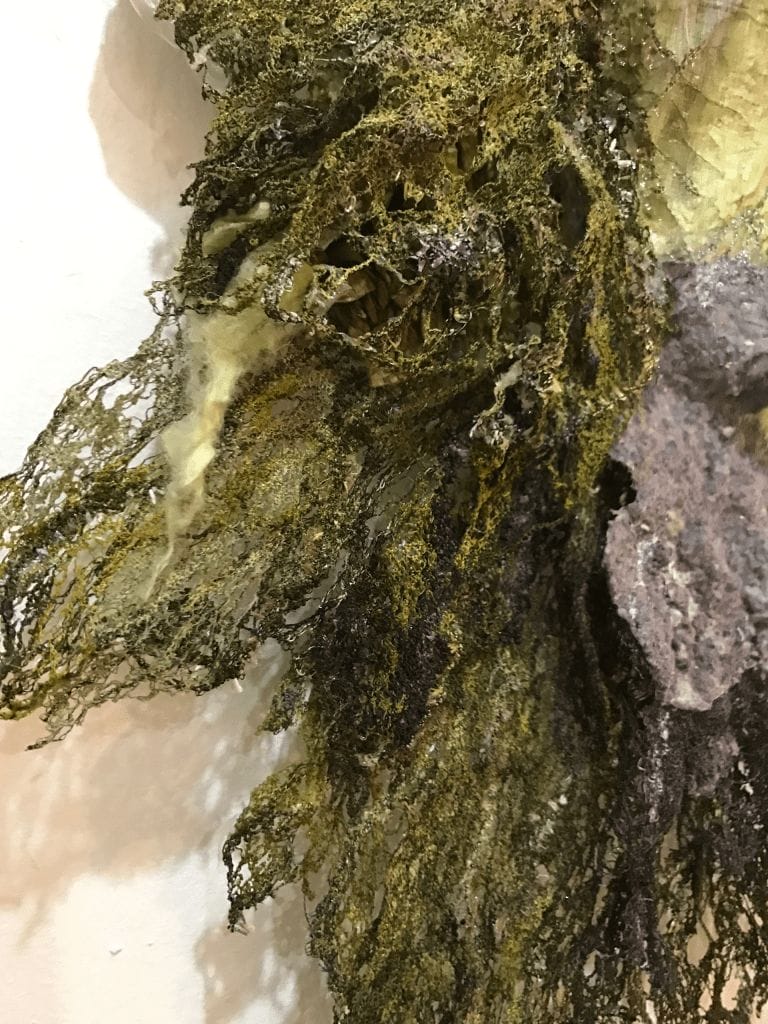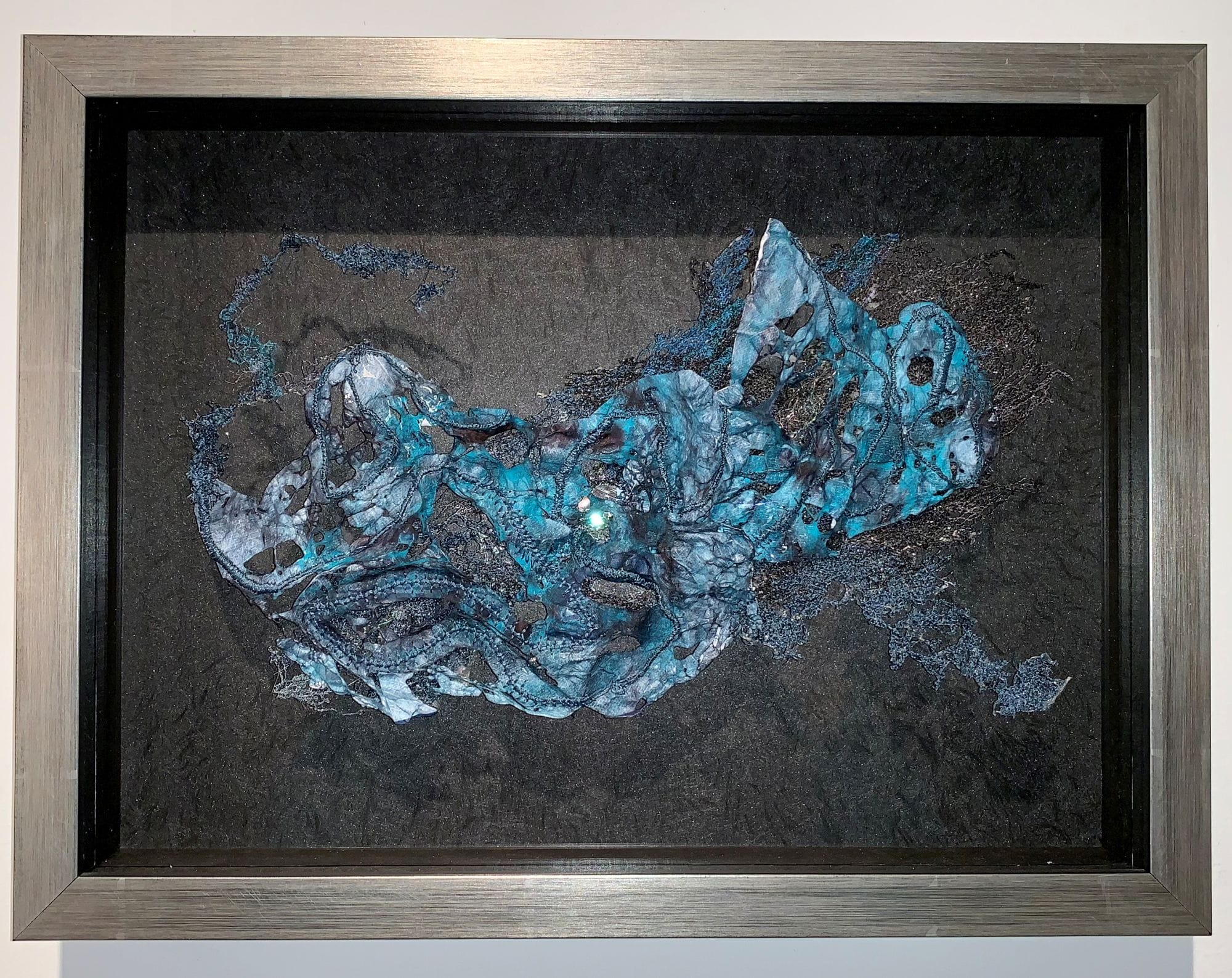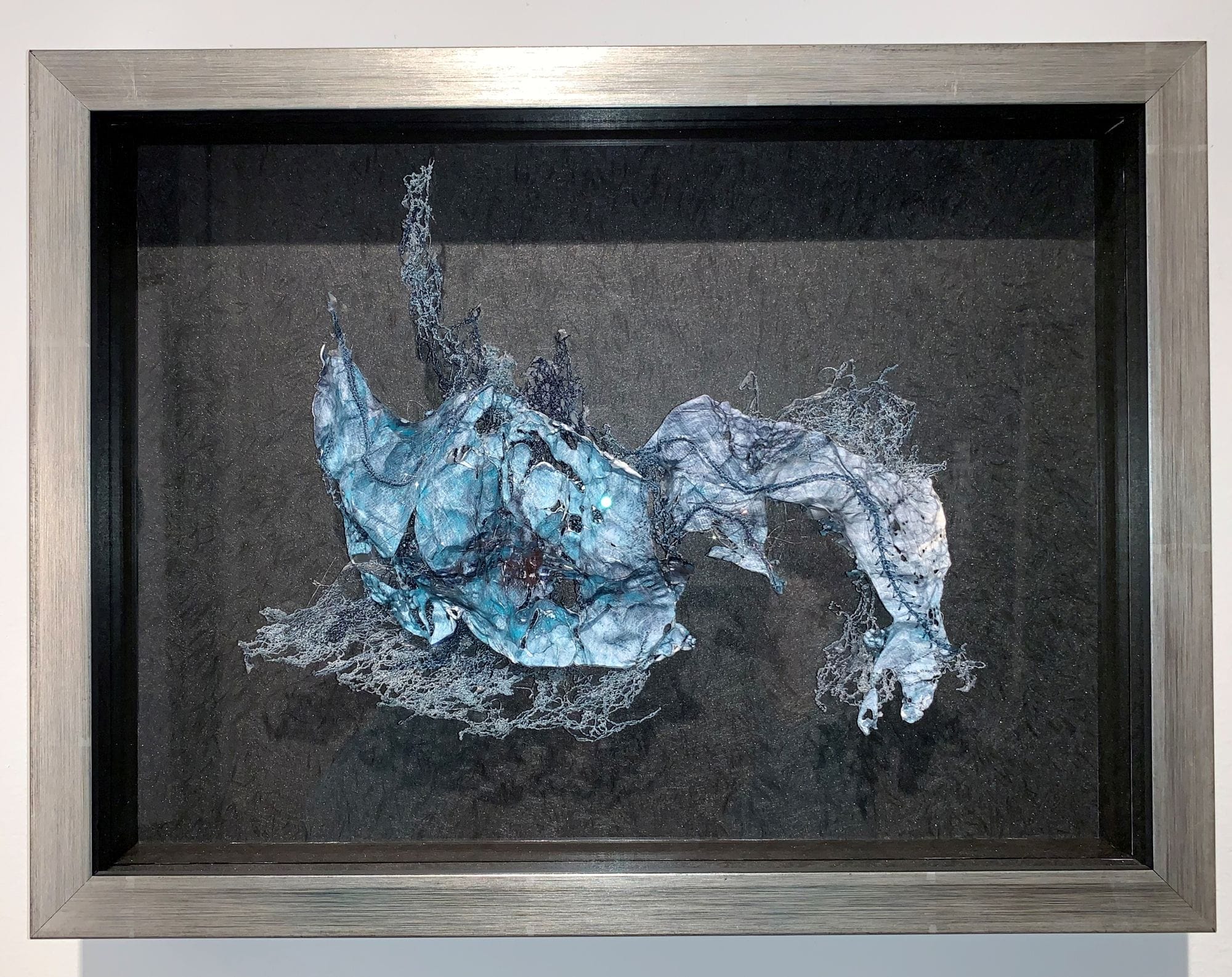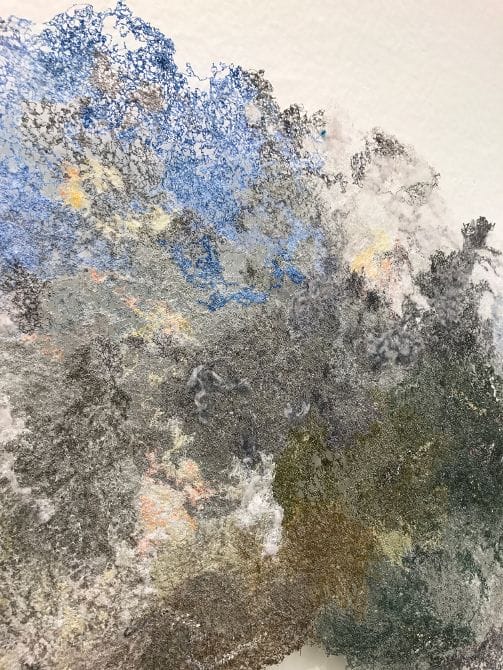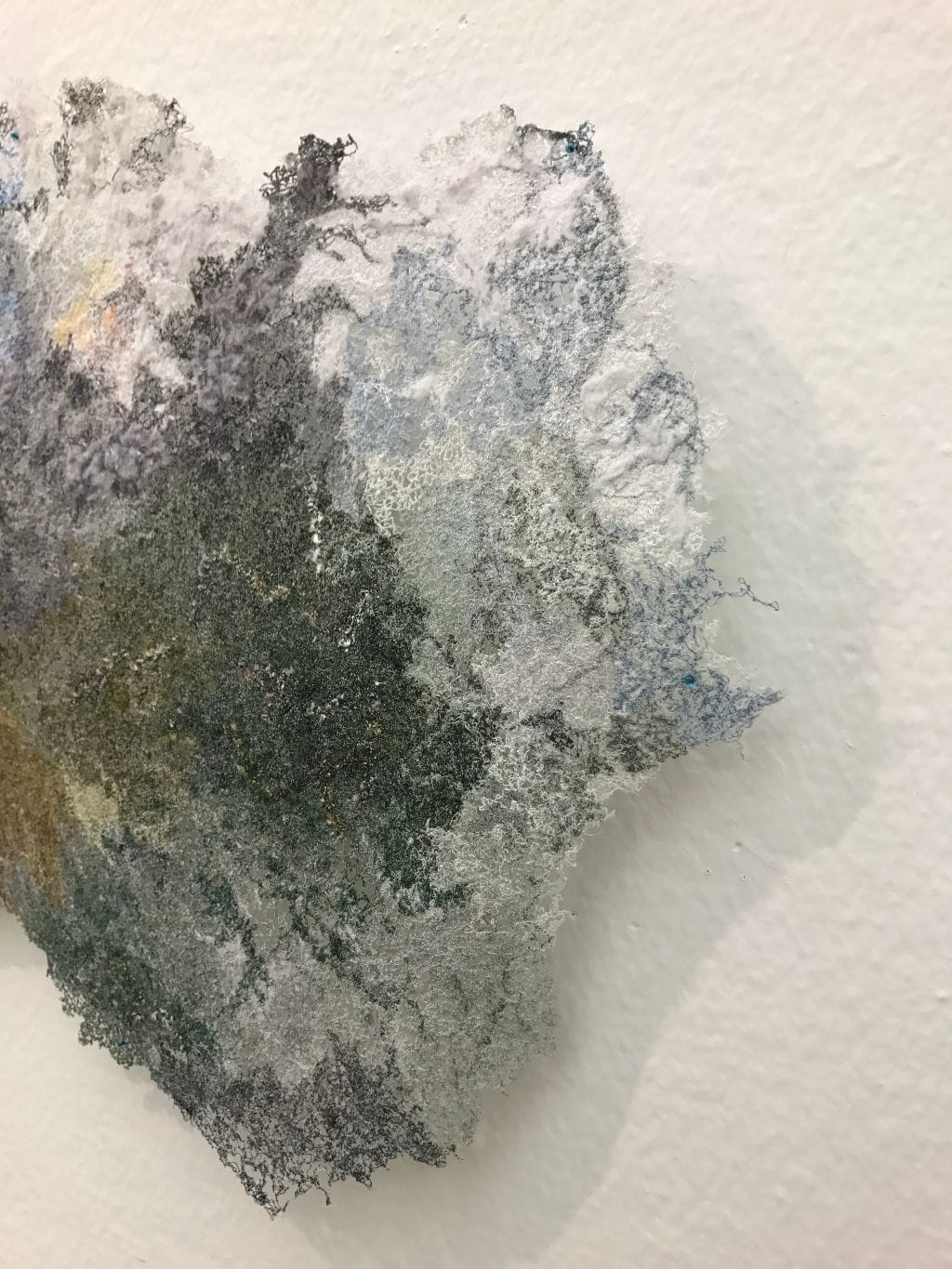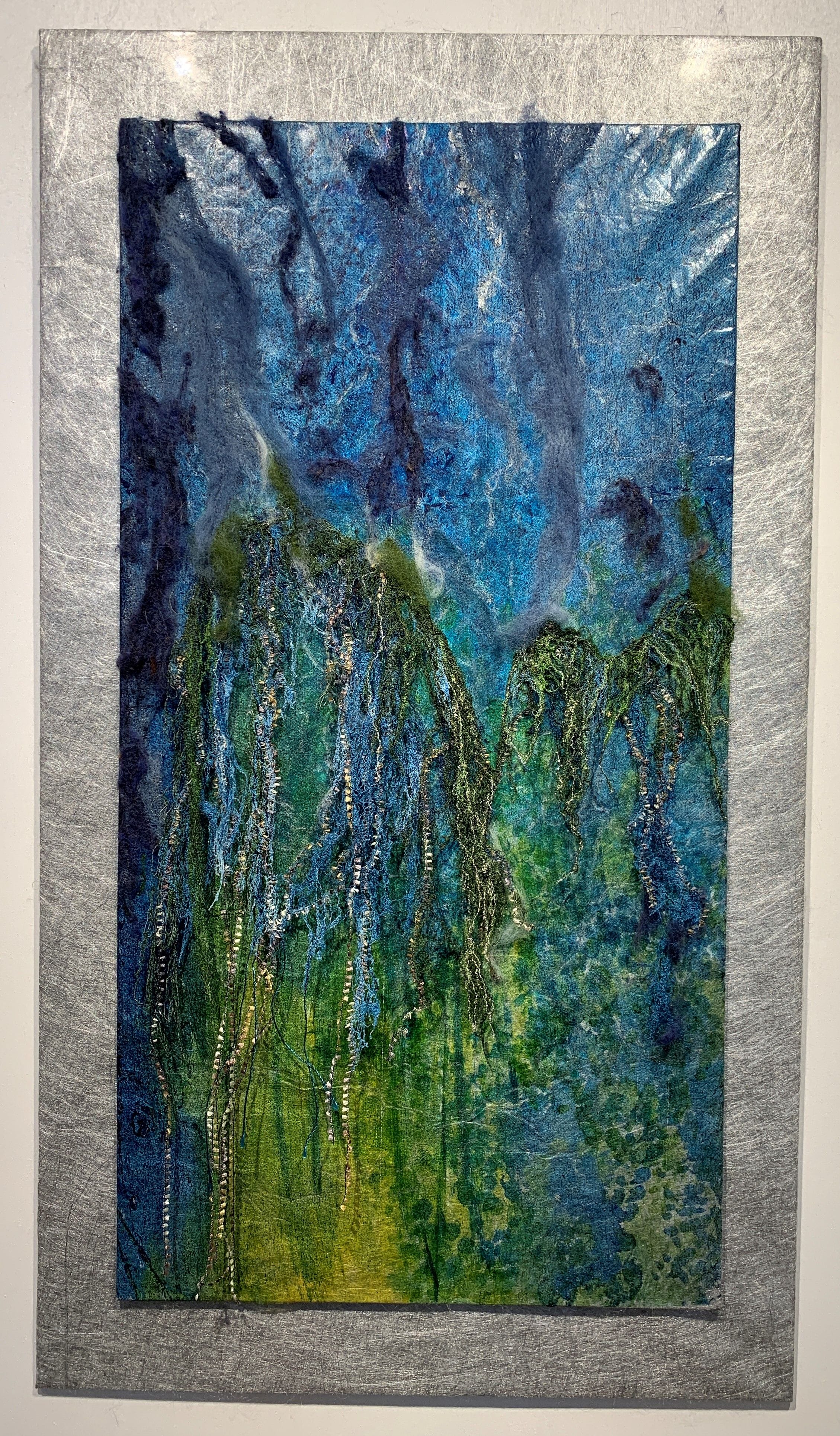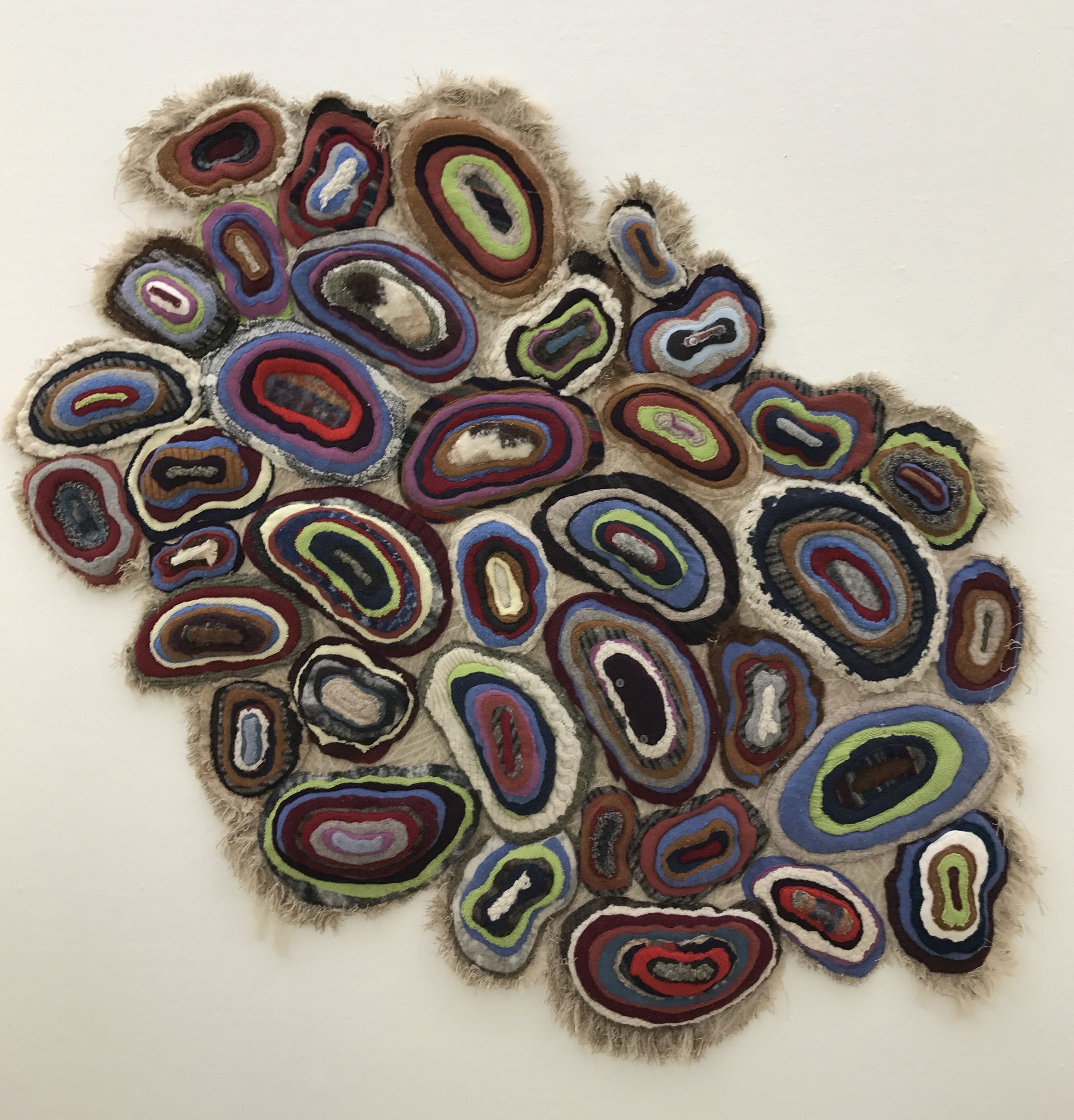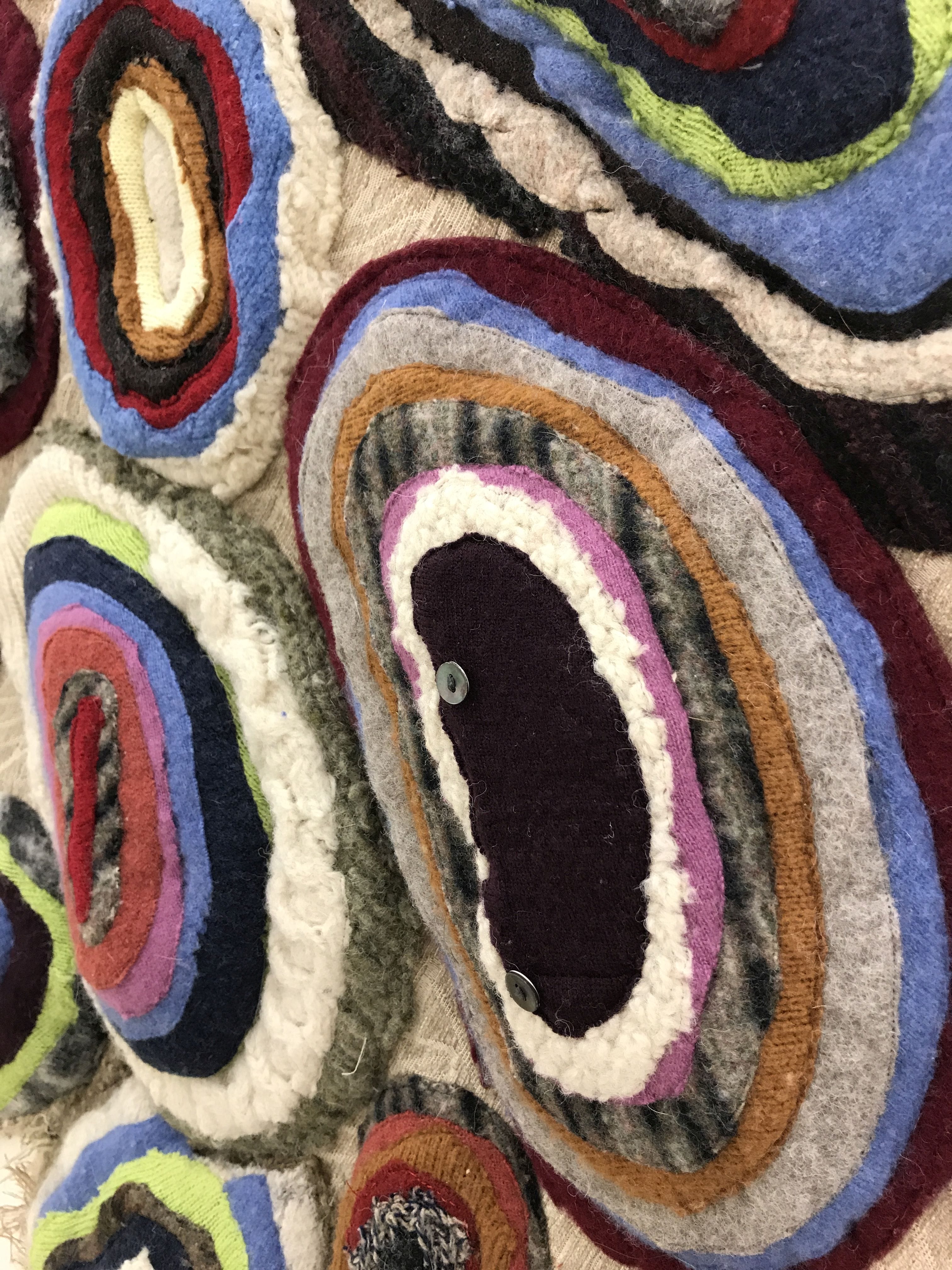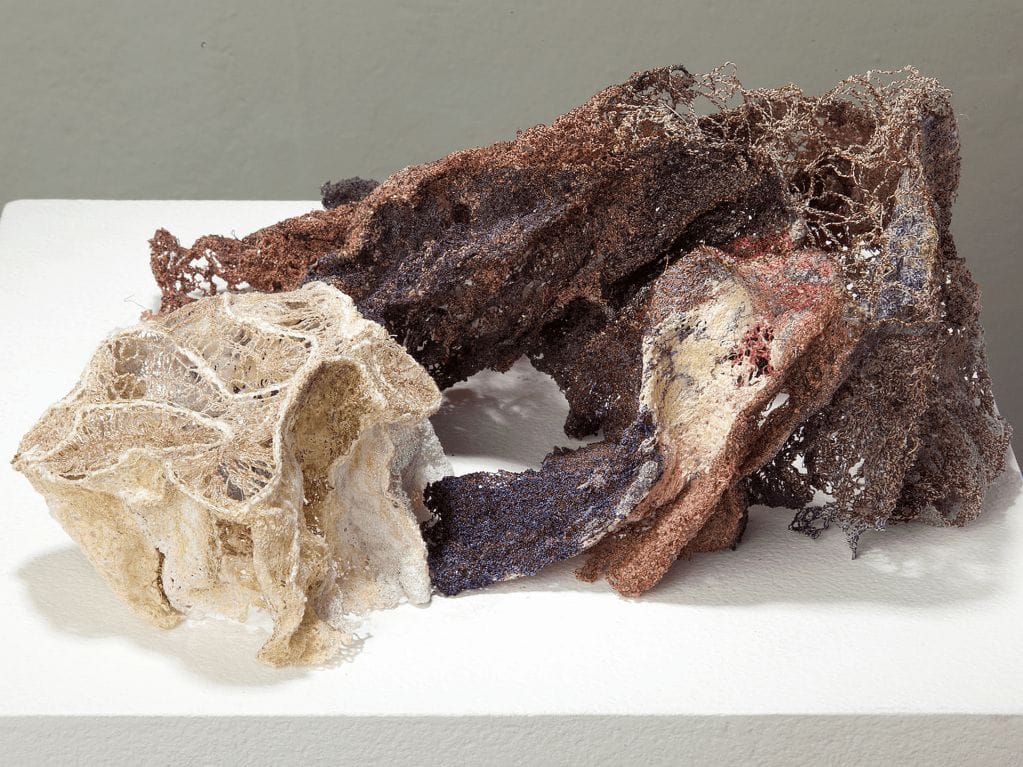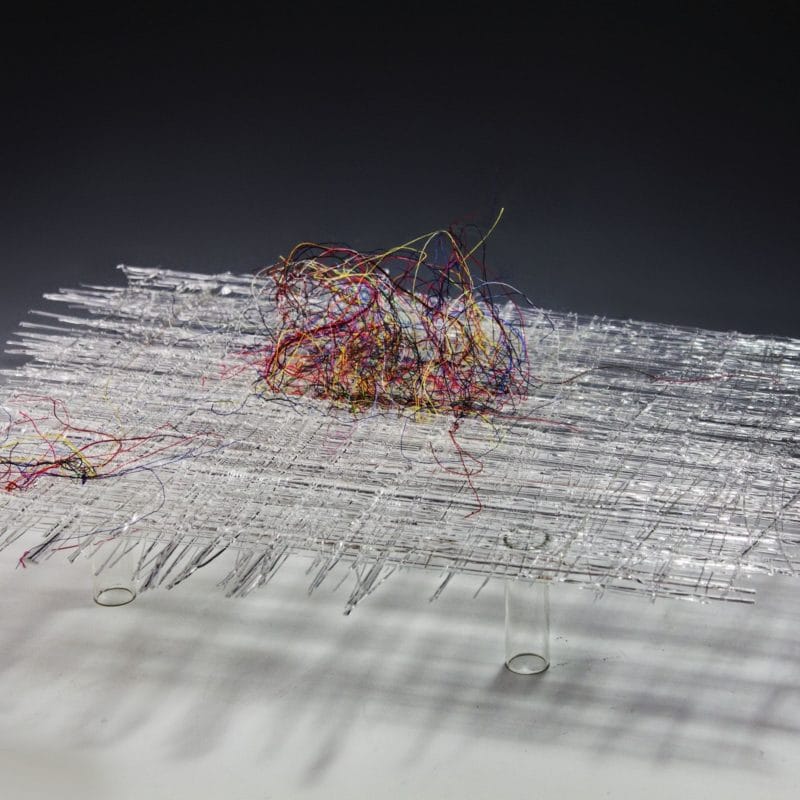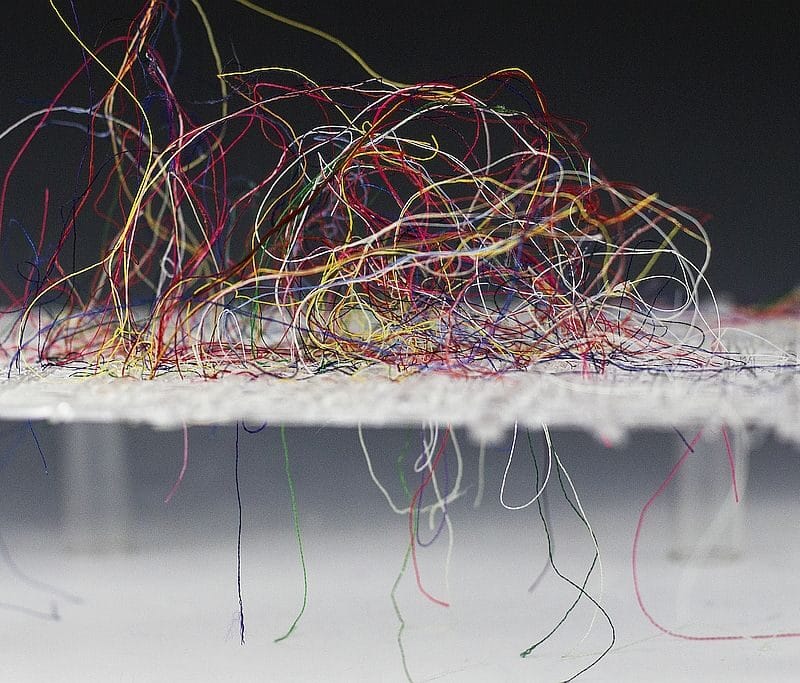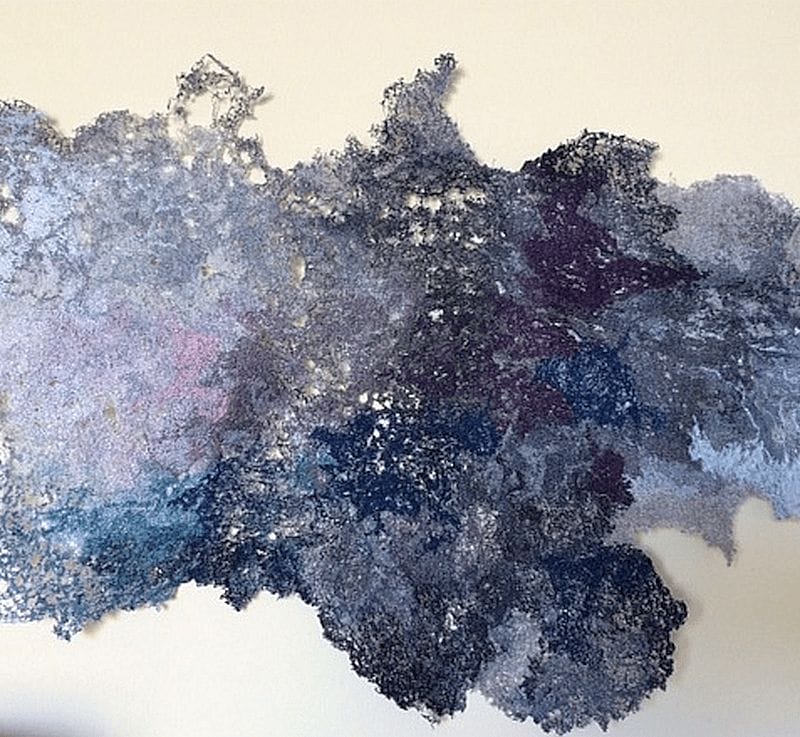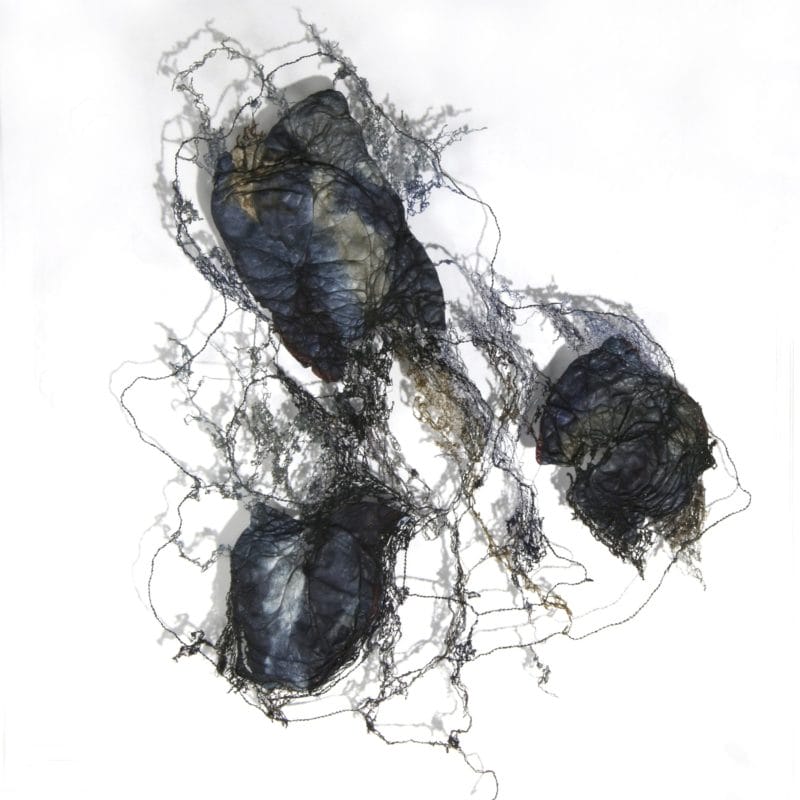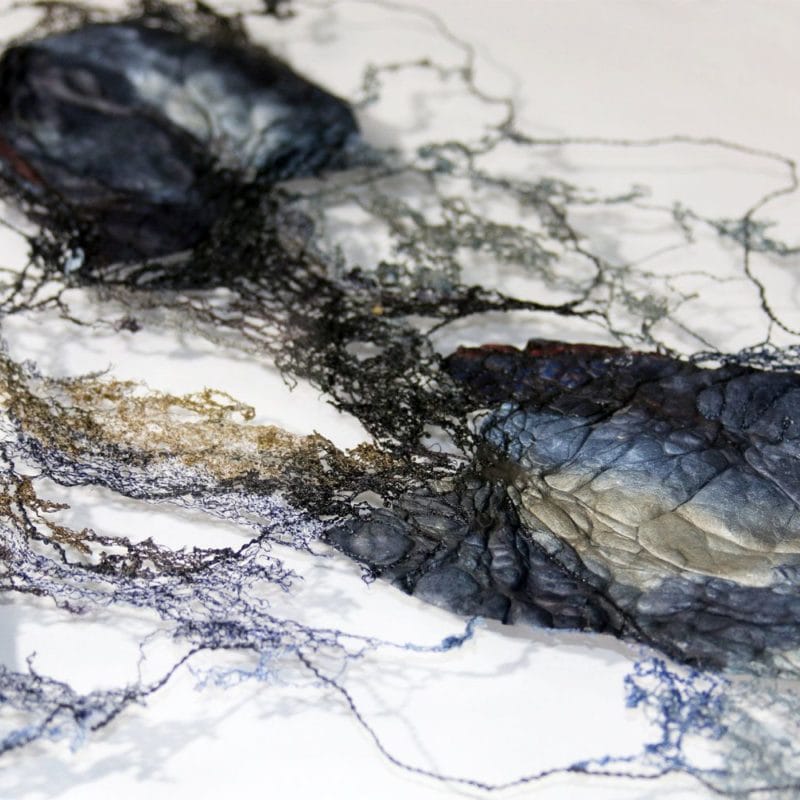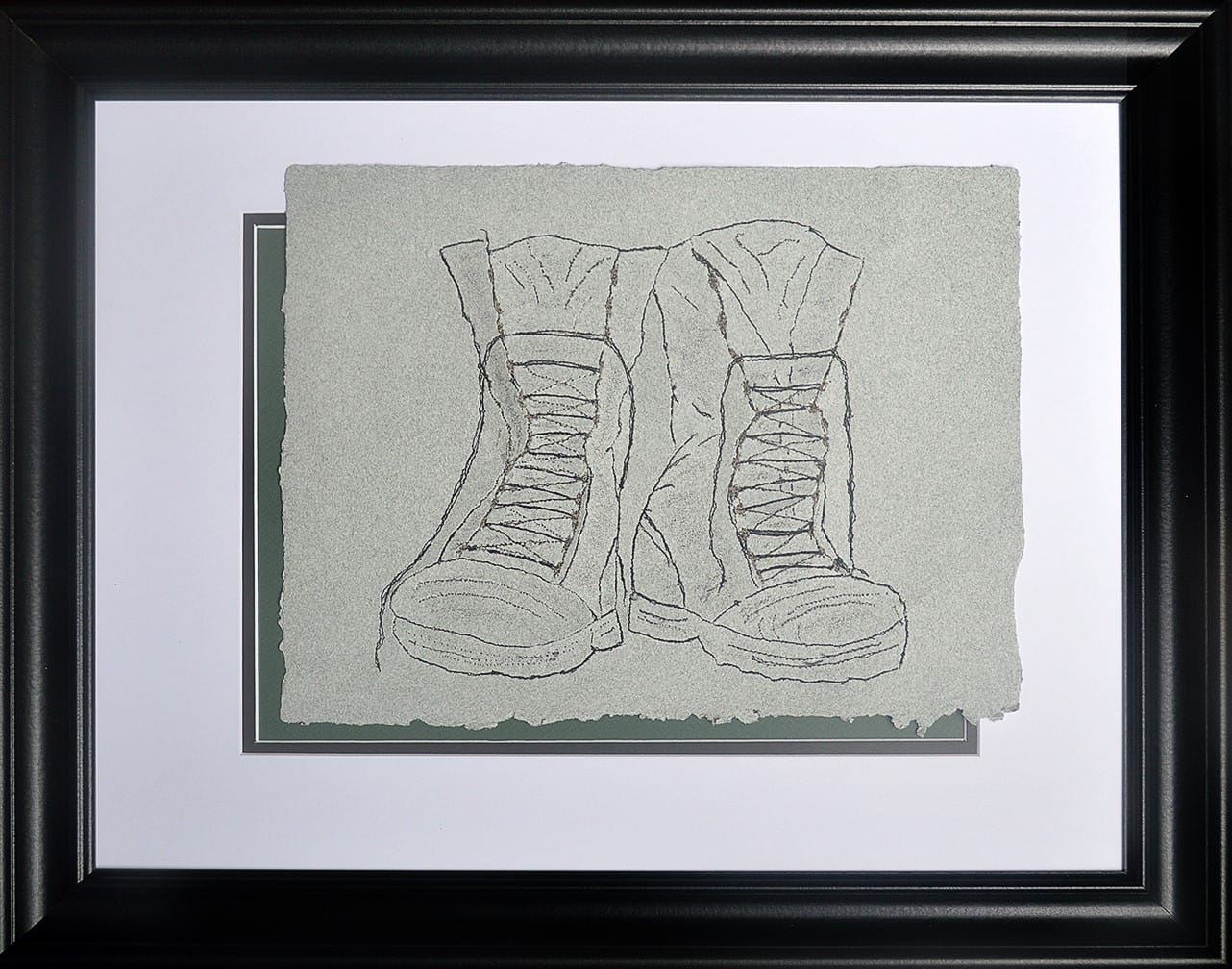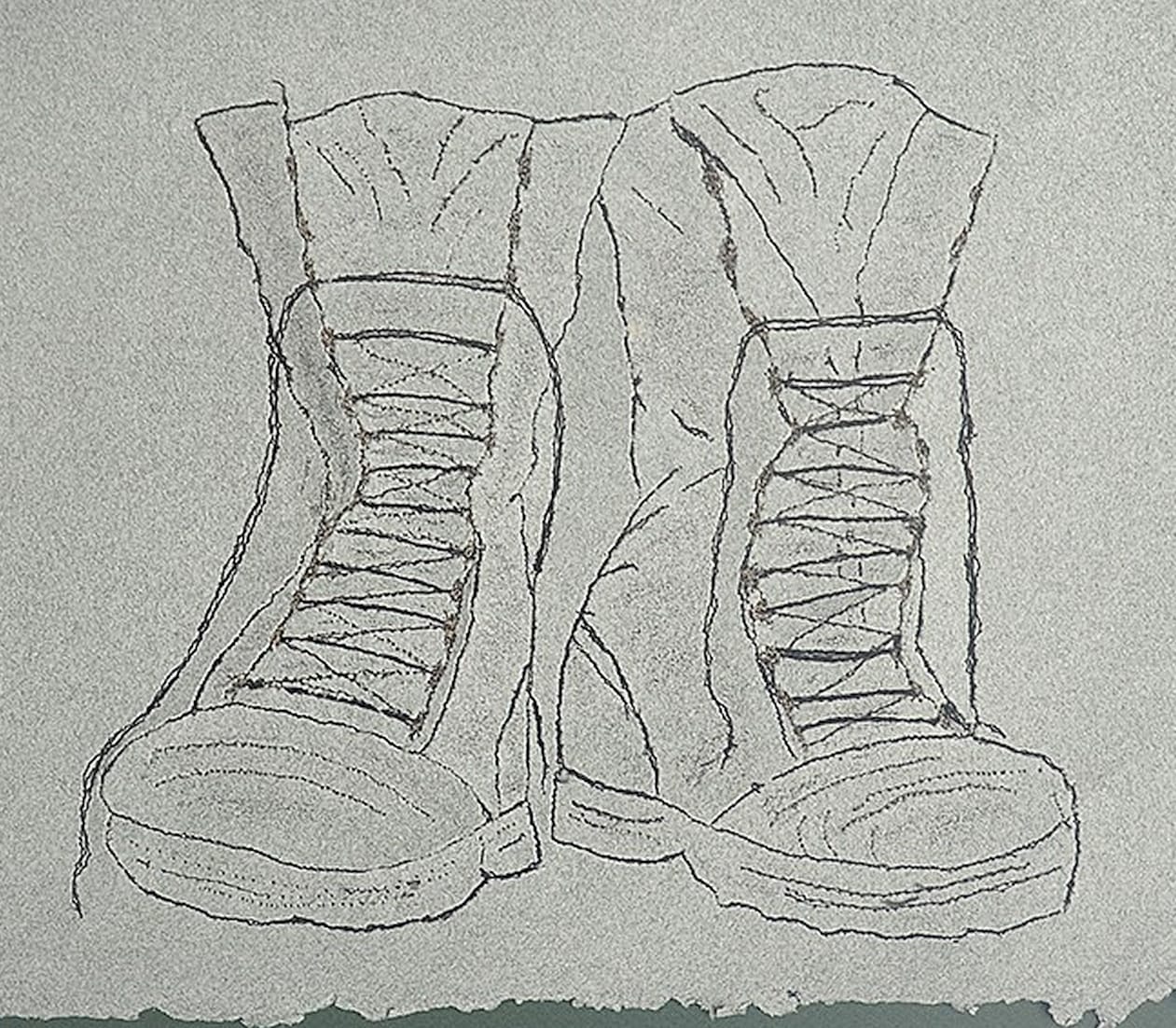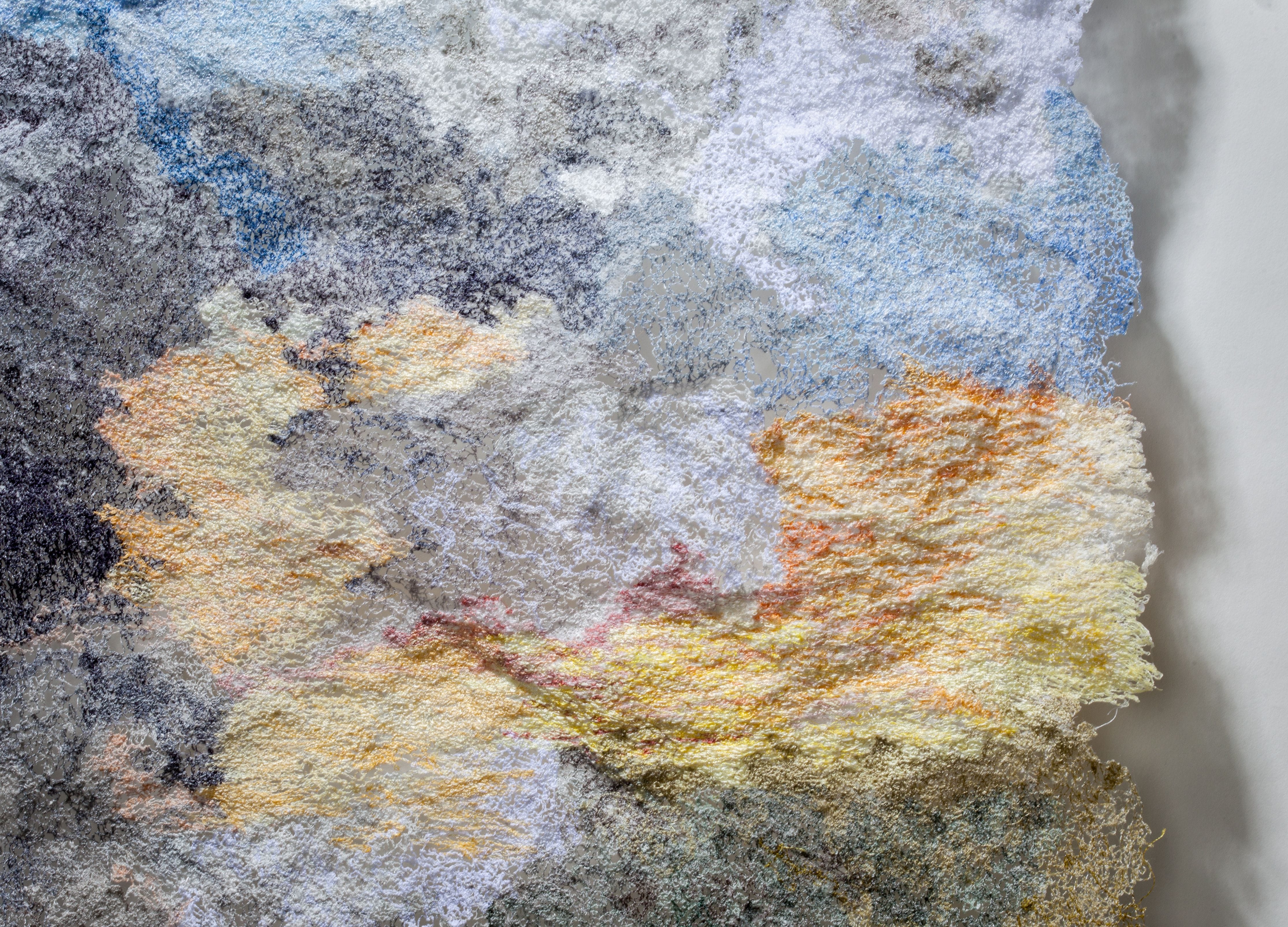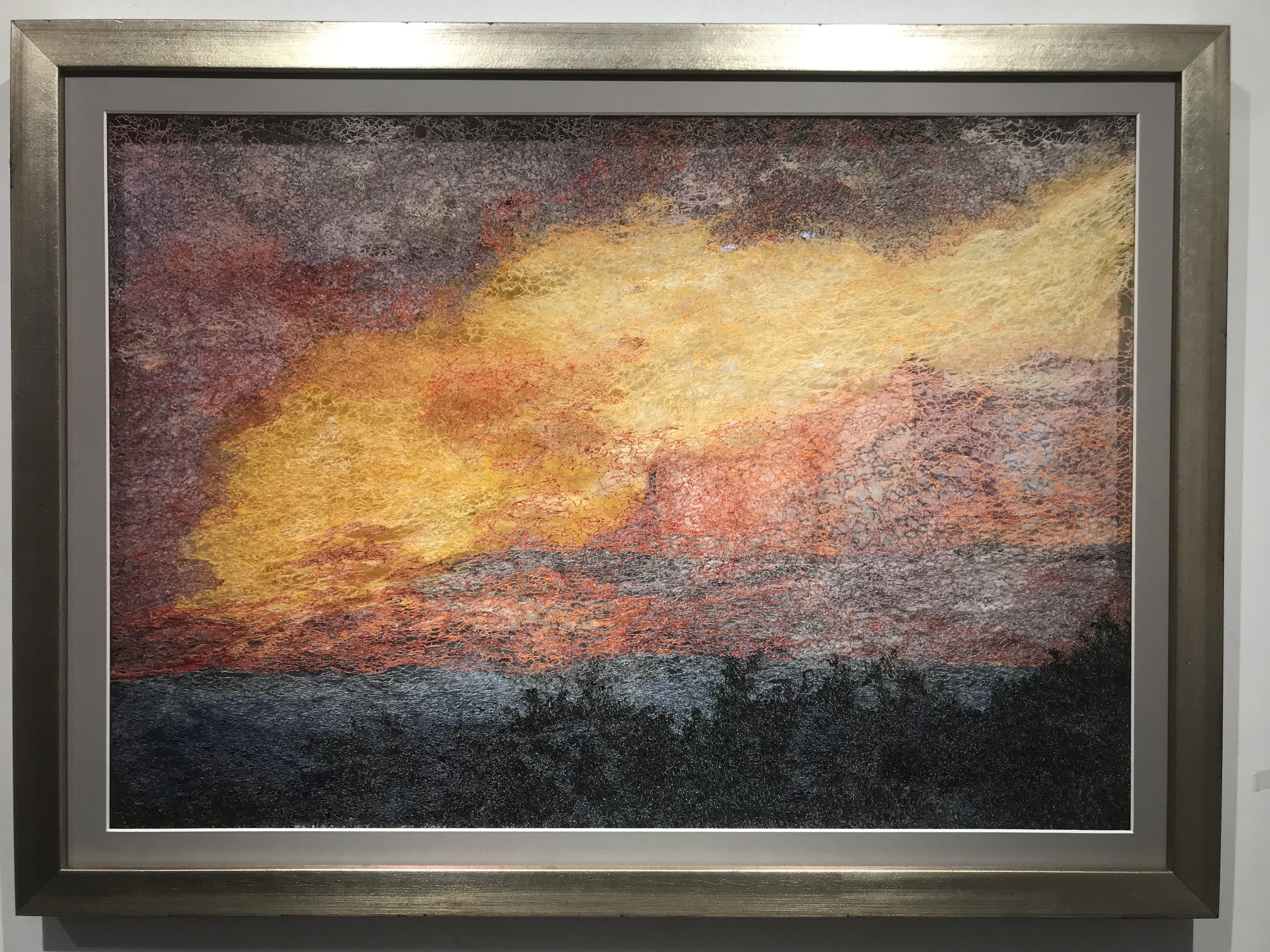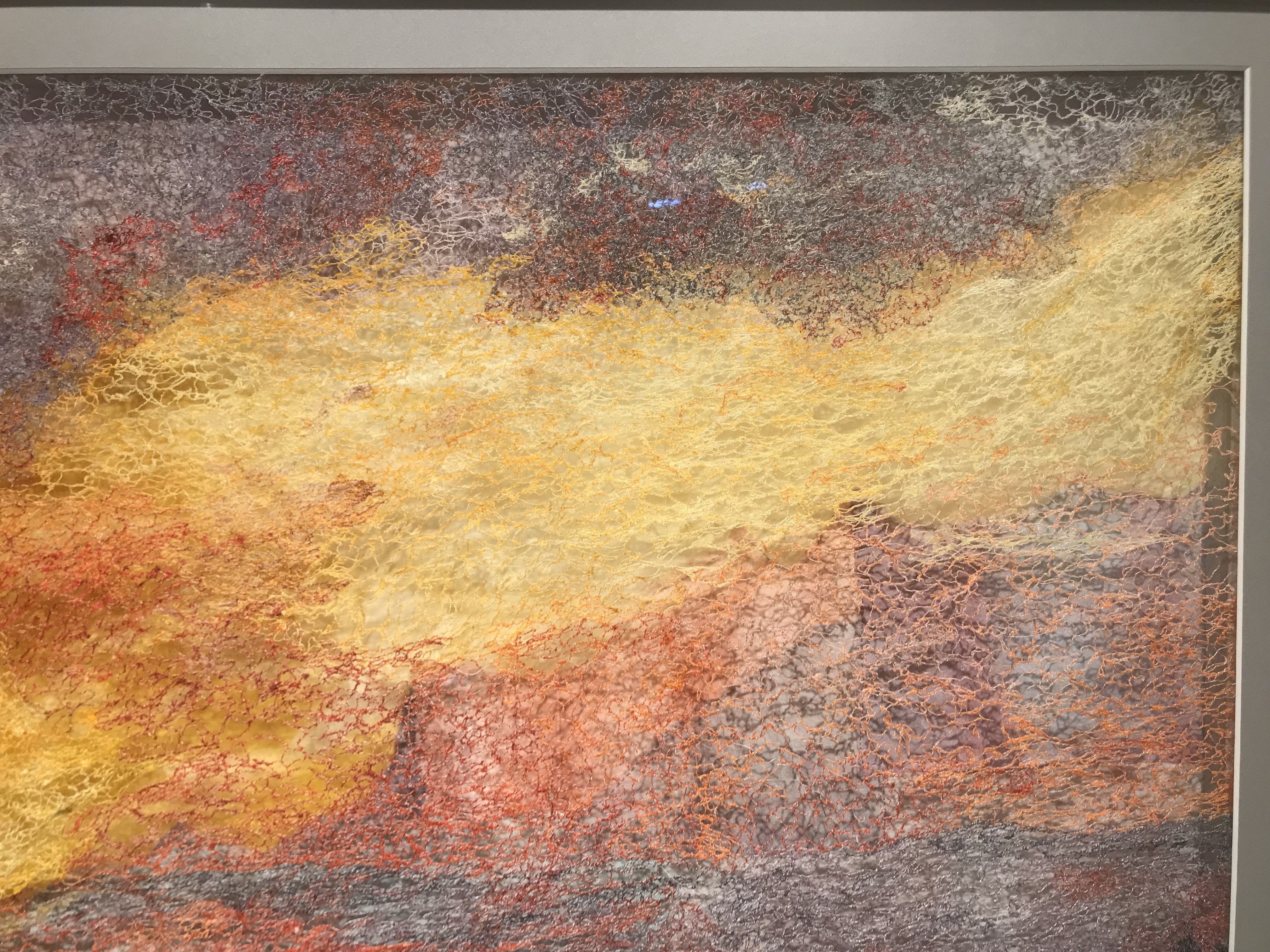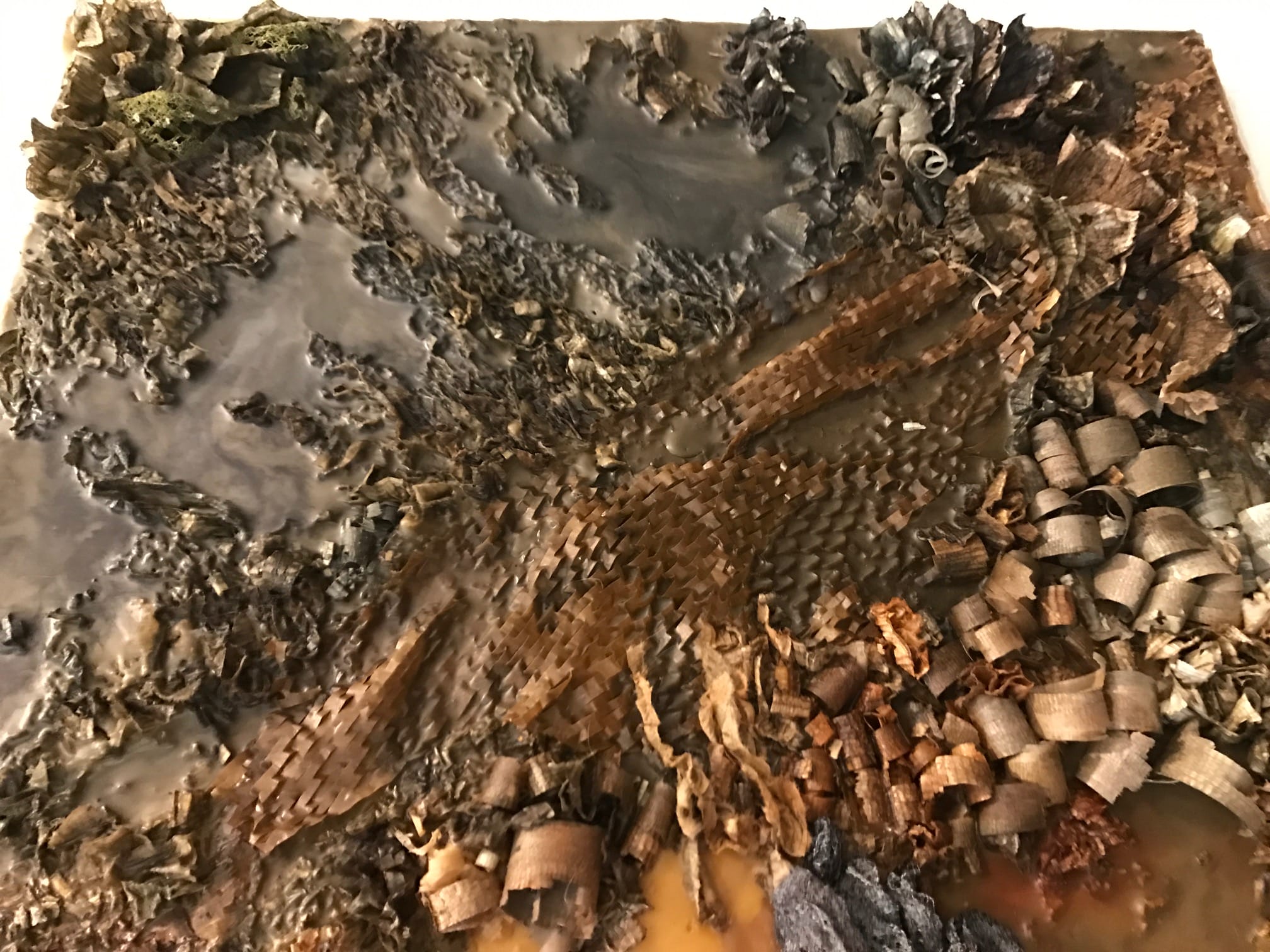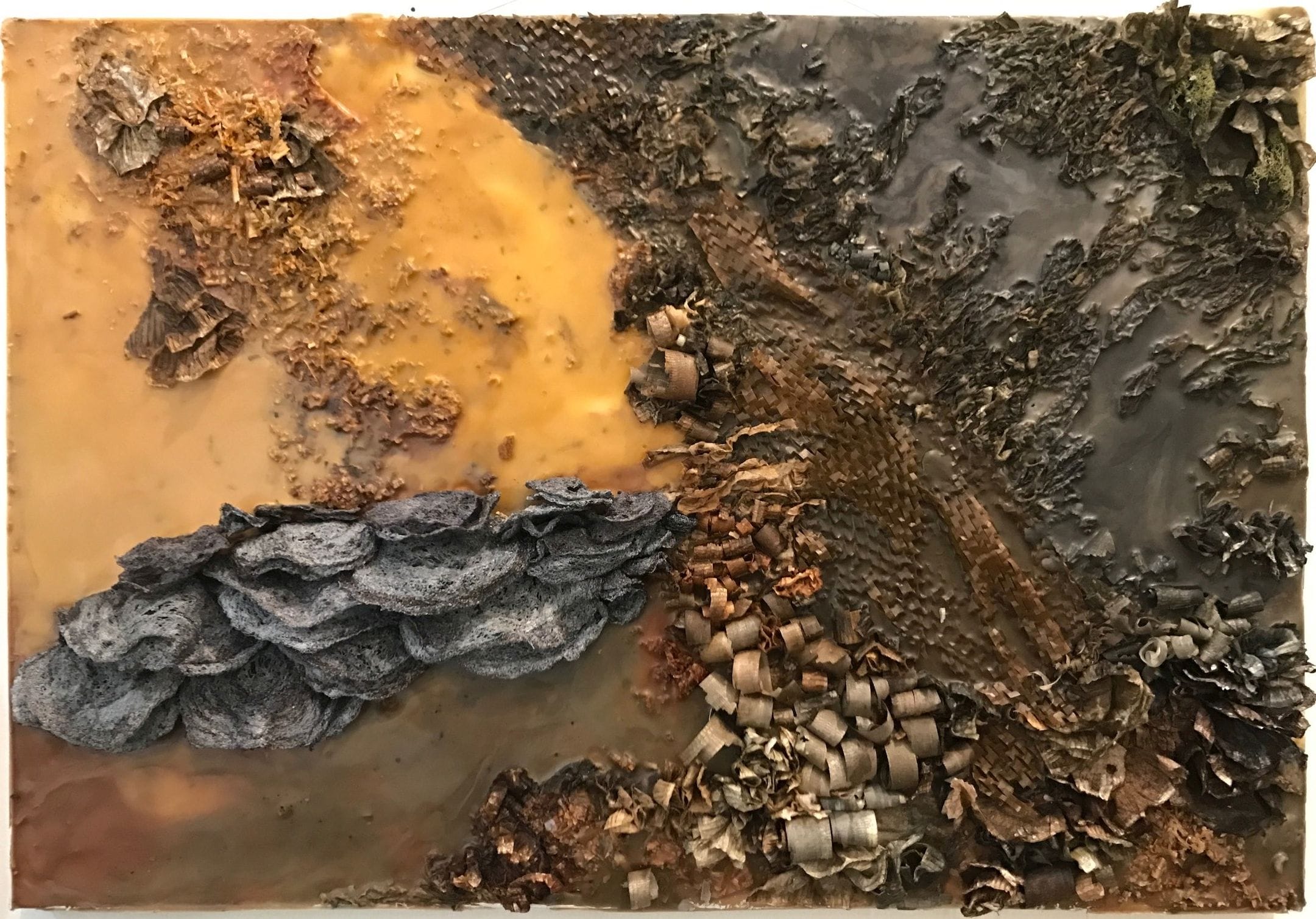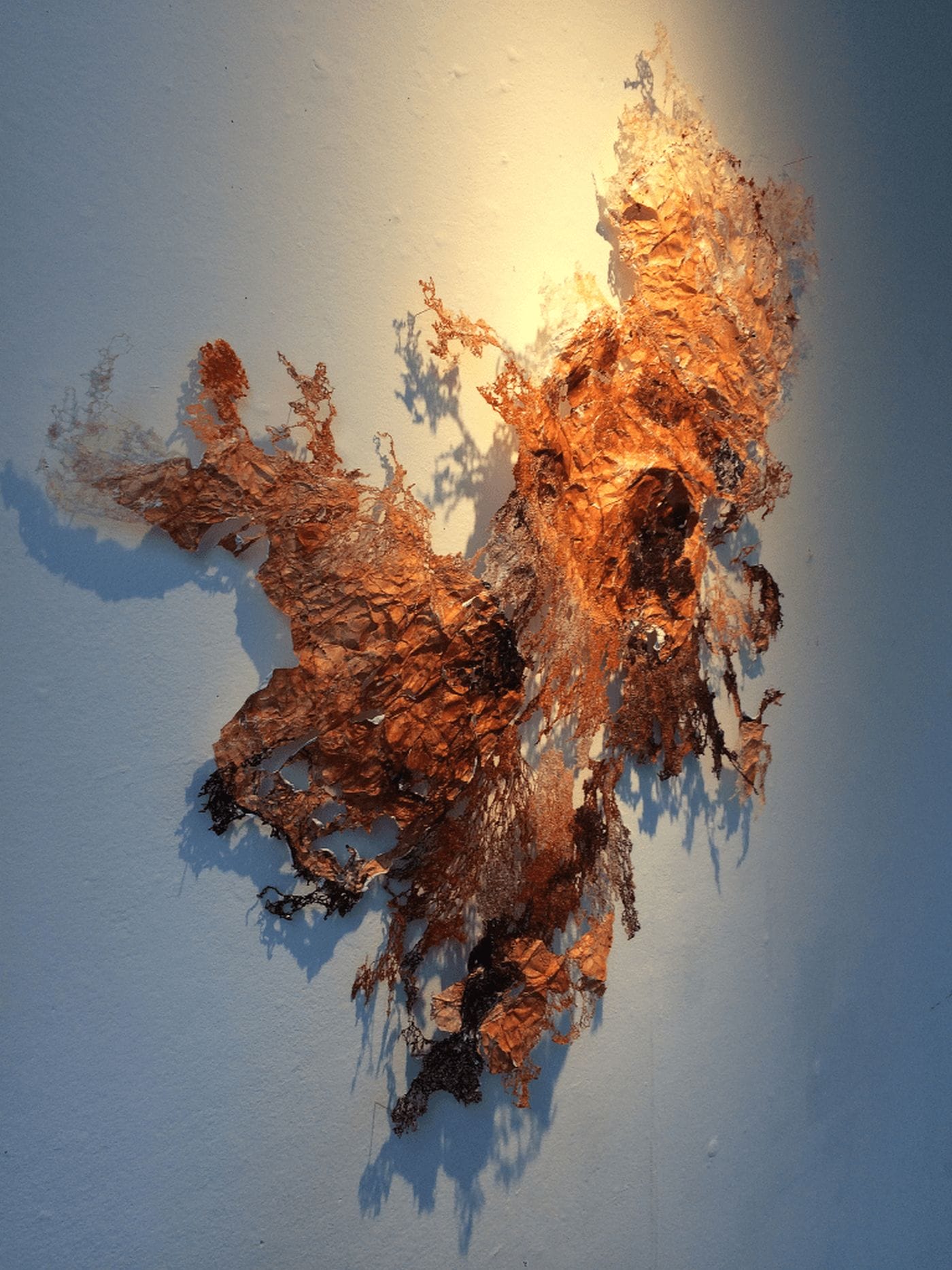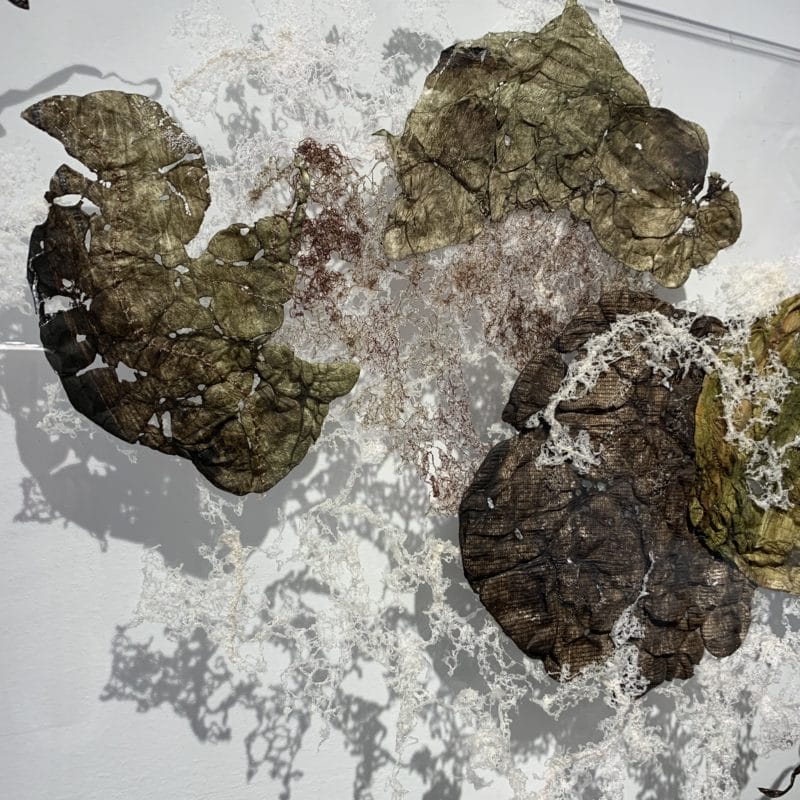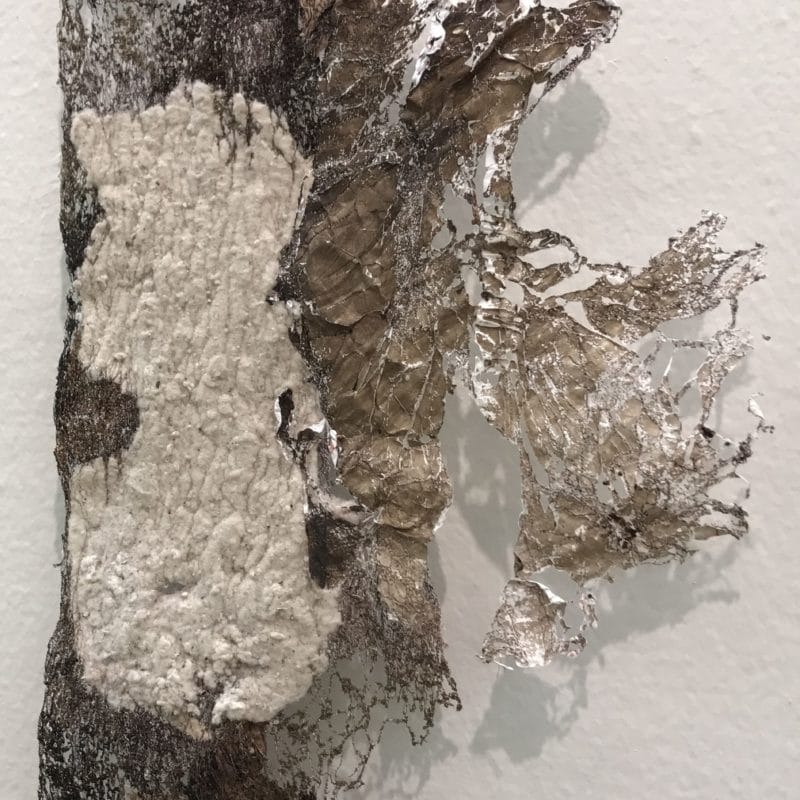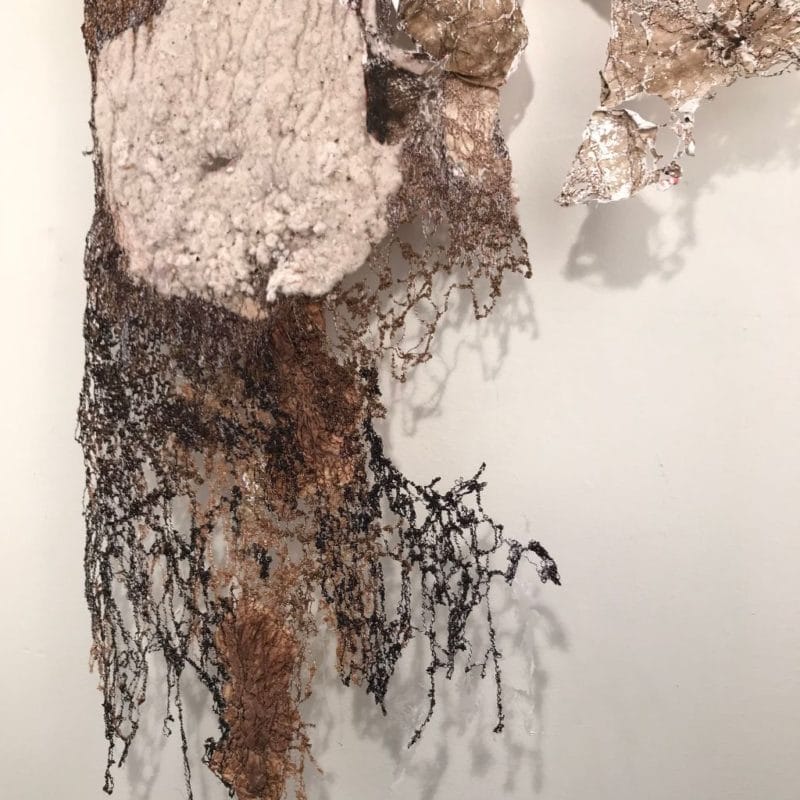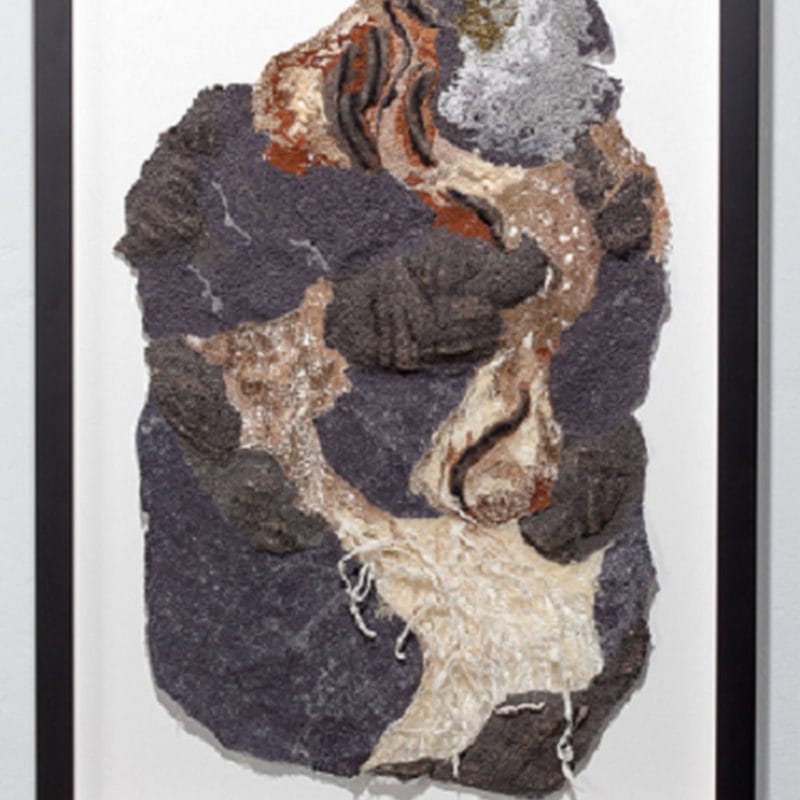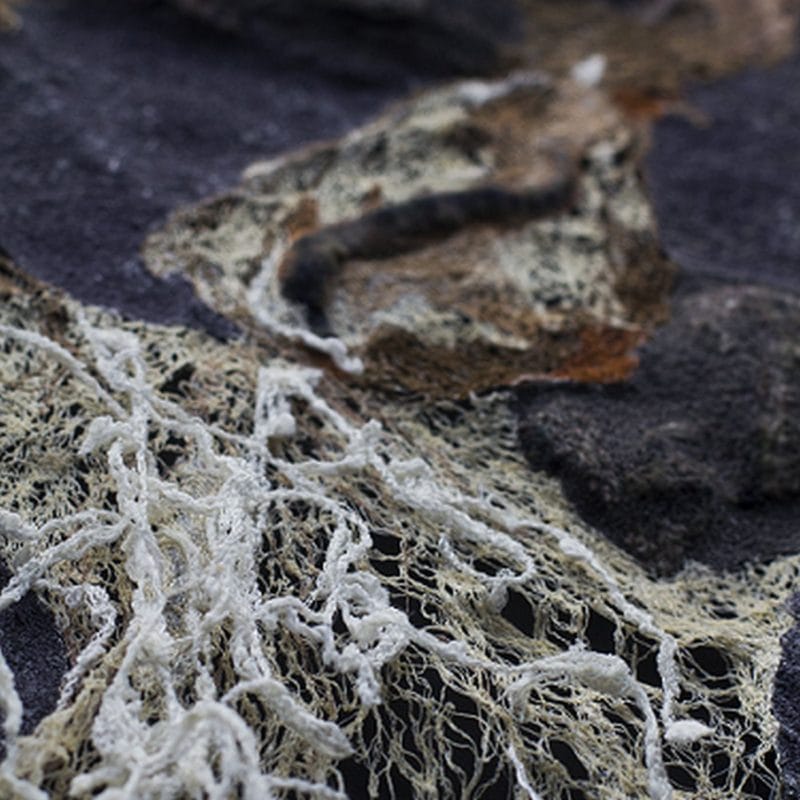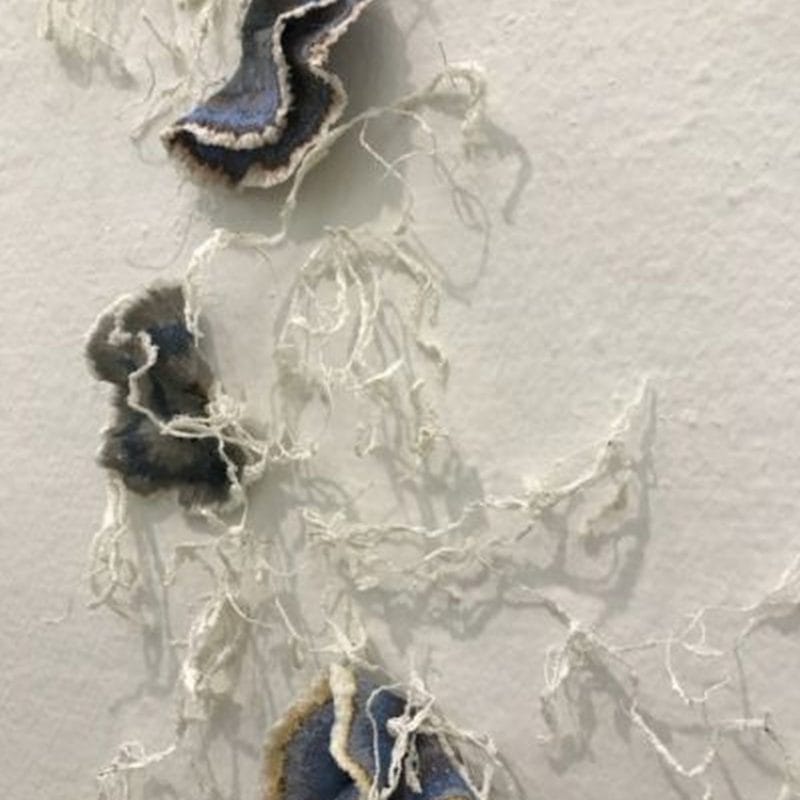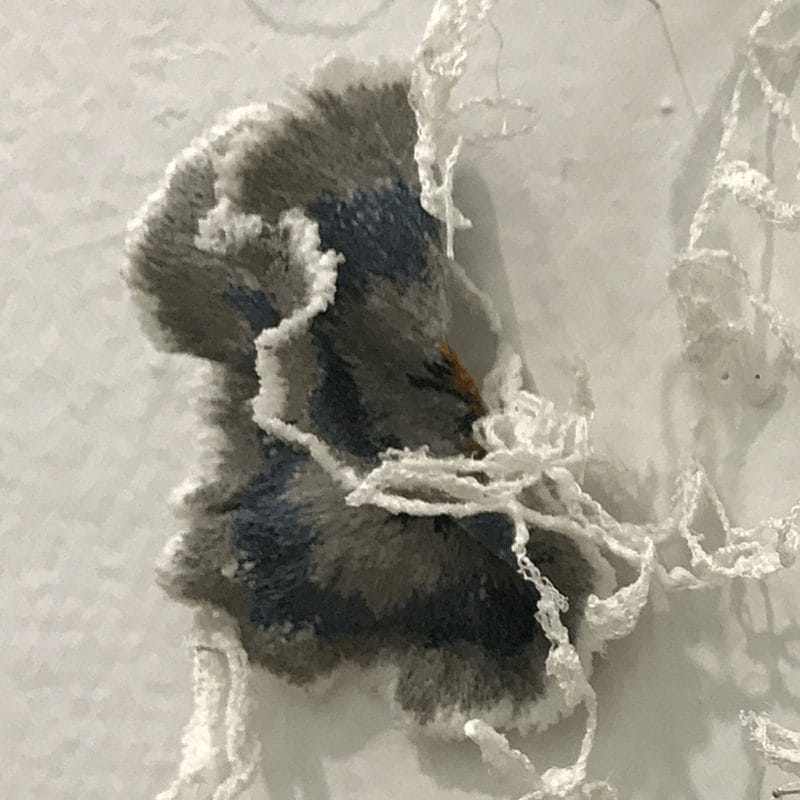Interview with Carla J. Fisher

Carla Fisher is an acclaimed fiber artist who lives and works in Philadelphia, USA. In her artworks, Carla manipulates the textile element by transforming the simple thread into sculptures and abstract compositions, vibrant and intense organic forms that arise from the strong and visceral need to express their emotions of loss and emptiness in a creative and constructive way, the day after her husband’s death. It is from here, in fact, that her career as an artist began, in 2013 when, after twenty-five years dedicated to the financial services sector, she decided to start studying again and to graduate (in 2016) from the University of the Arts in Philadelphia.
Carla Fisher’s textile works have been exhibited in numerous exhibitions in the United States, Canada, Korea and Ukraine. Today the artist works mainly on commission.
Below is a link to the artist’s website:
Carla, when did you start to approach textile art and why?
I can still see my mother’s face beaming as she would tell the story of how, when I was two years old and she would sit at her machine to sew, she would place me on the floor next to her with what I envision to be a quilting hoop and I would “sew” as she would sew. By the age of four, if she left the machine to grab a cup of coffee or answer the telephone, I would jump up in the chair and begin “sewing” on her machine. She decided then and there that she should teach me to use the machine lest I damage it beyond repair. Throughout my life, I always sewed. As I reflect back, sewing was always my comfort. But never did I ever attempt anything artistic. After all, my seventh grade art teacher, Mrs Conner, strongly suggested I “seek another creative outlet since art was not it”!
But life does take its twists and turns, and on October 12, 2013, my husband died from cancer. After forty years together, I had to find a way to take a “We” and make it into a “Me”. A dear friend suggested I get a notebook. In that notebook, I was to write all the things that even remotely interested me. “Do not judge it! Do not justify it! Just write it down!” she admonished. Thank goodness for once in my life I listened to someone! Through this process I learned that what really interested me was art. I made the decision to go back to school. I chose the University of the Arts in Philadelphia, PA because they had a program called the Post Baccalaureate Program that allowed someone who already had a degree in another field (in my case, Finance) to prove that they had proficiency in a primary discipline (Fiber) and two sub-disciplines (large metal sculpture and glass blowing) and upon successful completion, one could matriculate directly into an MFA program. I graduated in May 2016.
What are your sources of inspiration? How do you choose the subjects of your works?
I truly believe that there is no greater artist than God Himself. Some prefer to call it Nature. The colors are ALWAYS right. The textures always allure. God’s patina is sometimes soft, sometimes twinkling with dew. Sometimes the contrast is bold, like the bright purple striations of little crocus of spring, or subtle like the fuzzy blue green leaves of a fiddlehead fern that signal the start of a new growth season. Sometimes the tones and shades and textures of winter browns and greys and whites stimulate my brain. Everyone loves the glory of fall, but did you ever notice that the green you see in summer is different than the fresh green of spring or the tired, yellowed green of autumn? The June sky is even a different shade of blue than the one in November. The pallet never ceases to inspire when one takes the time to observe!
I love walking in both the city and the woods. Often a vignette will capture my eye or take my breath away. Sometimes I simply appreciate the way an architect has layered his manmade world inside Nature’s domain…and how Nature reclaims it with spritzes of growththat we call weeds.
Sometimes it is just the shape of something that my brain won’t let go, and I just have to try to recreate that. Maybe it is the “holes” that irregular growth or erosion of time has left somewhere that intrigue me.
Stated another way, color, texture, shape, patina, and juxtaposition intrigue and inspire me far more than any scene or portrait that I could ever capture.
In your textile artwork, you use threads in a special and unusual way. How did you develop this technique?
In my first class at UArts, I had the great fortune of studying under the great Warren Seelig. Little did I know the value of his tutelage, much less how he would change my life!!! In his class, Constructed Surfaces, we were challenged to make a surface out of nothing. He did a slide show presentation where he showed different inspirations, one of which being a picture of moss at an artist retreat in northern Maine known as Haystack. I had remembered this water soluble material a friend had shown me once, so I decided I would try to replicate that moss for the assignment. The rest, as they say, is history!
I continued to push the medium through experimentation, working at first to discover color shadings that would give me the watercolor effect that has become a hallmark of my work. I decided to challenge convention even further by attempting to sculpt three dimensionally with just the thread. Through many, many attempts, I learned that only the one thread, Robeson Anton rayon embroidery thread, would absorb the stabilizer as I needed it to do. I also learned that I must work the erosion just one tiny section at a time to effectively shape the work. Often, the painstakingly slow sculpting of the three dimensional works take longer than the actual two dimensional stitching that precedes it!
It has been a huge awakening for me to learn how closely science and scientific study and methods relate to the construction of art! I am constantly trying new methods for shaping and learning the tensile strength limitations of each, scratching notes in my moleskin as I go. Between specific artwork projects, I often will spend several days to maybe as much as two weeks just experimenting with other ways to work with the thread and with other materials. “Brain stutters” of “what shall I use to get this or that?” are minimized as I start a new piece because I have already discovered a material or process that will give me a specific color, texture, or patina. I can then just allow my creativity to flow.
Can you tell us about your textile work Happy? How did it come about, what techniques and materials did you use?
Happy is almost a “one off” with my work that started with a school project. In one of my drawing classes, we were to do a classic echo drawing of a small object. In this case, I used a bobbi-pin or textured hairpin as it is known in some places. Being newly introduced to this idea of drawing, I found this simple method of drawing totally fascinating! I kept envisioning this pen and ink creation repeated in felt! Months later, when I returned to the house my deceased husband and I had owned together, I found several boxes of sweaters (many of which I had knit for my family over the years) that I immediately felted. Creating a pattern from the original drawing, I cut and stitched convex and concave layers to create the colorful shapes that people often think are geodes when viewed from a distance. I seldom work with any type of fabric in my work, so to have this one predominantly made with something other than thread makes it much different than my usual work.
“Happy”, 47”x67”x3”d, felted wool sweaters, 2016, copyright Carla Fisher
What do you think is the most important difference between a craftsman working with threads and fabrics and a textile artist? When does a textile work become art?
I would like to start answering this question by reminding you that I never studied art as a young person. My background is in finance and I worked in the brokerage industry in Germany and the United States for a total of 25 years. My 7th grade art teacher, Mrs. Conner (for whom I have named the big colorful blood moon piece) had admonished me that I “should choose another creative outlet because art just isn’t it for you”. I spent my entire life convinced that I could not draw or do anything artistic. I marveled – even envied — how artists could express themselves so beautifully! Yet, when Ed died and I had to do that remake of forty years of “We” into a new “Me”, becoming an artist was that illusive pinnacle, the one challenge that I just had to pursue! I tell you all of this so that you will understand my very simplistic, layman type answer to your question that arises from a lifetime of admiration more than stuffy declarations by “authorities”!
You see, despite the “Masters” and their definition, I personally believe that craftsmen are artists. But we like to categorize people and things, so we give them the affectionate alliteration, artisan. Being a craftsman so often means that The School of Hard Knocks and Experience granted their artistic credentials, and even when formalized education at university is acquired, those of Crafts and Material Studies are somehow viewed as the lesser degreed than those of Fine Arts.
Increasingly, however, we see more and more “borrowing” of the craft techniques and skills by the Fine Art world to enhance their work. I happen to choose to thrust Craft into Fine Art in my work by using craft materials to suggest the utilization of the techniques of fine art. It has been said by many that the lines between the two are justifiably becoming blurred and finally the contributions of craft to fine art are becoming recognized for the nuance they bring. I’m just trying to help that process along a bit!
In the most simplistic of divisions, however, my thoughts are that craft addresses the practical, the useable, the purposed creations that touch our daily lives whereas fine art exists solely to stir emotion and joy through the beauty it offers. My work, by this definition, falls into the fine art world, with each and every one of its root fibers clenching to their foundation in craft.
Can you tell us about a your textile work to which you are particularly attached?
Illusions will always be “the” piece for me personally. It literally launched my career when it was in an all Philadelphia art school show and adored by a curator from Korea. Each time it was in an exhibit, this piece spawned multiple opportunities for further shows of other work. I have had the opportunity now to show in five different countries and throughout the United States as a result.
I also love Homage to Weaving. As Warren Seelig, the beloved professor who kickstarted my art career used to tell me, “Carla, you are a fiber artist. You have to make peace with weaving!” As I continued my studies, I was taught to pull glass. I immediately knew the piece I wanted to create!!! The woven threads of glass interspersed with all those colorful knotted threads brought me great joy as I declared the War with Weaving over! Sadly, it was destroyed in shipment to a show, despite careful packing in a wooden crate. Someday I hope to remake that piece. It is just plain FUN!!!
Stradivarius is also a favorite piece. The lily pad like elements were an experiment with a new type of Tyvek that, once made, I just couldn’t bring myself to toss in the “experimentation bin”. They were revisited again and again for over a year and a half until I conceived a piece that would showcase them! Plus, the single machine knotted line around the work was a HUGE test of a new technique that pulled the work together.
All that said, however, let it be known that my favorite piece is always my next piece. I get so excited about the possibilities of seeing a work come together! Each completed element stirs my soul as I watch the entirety of a work come to life.
How important is the experimentation of techniques and materials in your artistic career?
Please see my answer above. My process is that I spend a considerable amount of time experimenting with various materials and methods so that when I conceive a new work, I know the capabilities of the material I will use to give me the exact effect I wish to have in the work.
Do you follow a scrupulous planning activity or do you let your instinct orient you?
Ninety percent of the work you see on the wall is exactly as it was conceived in my head. The remaining 10% is like wayward children: sometimes you just have to let them do their own thing and pray things work out all right!
Carla, can you tell us how your very interesting artwork “My Soldier Boy” was born?
Soldier Boy, aka now often referred to as Dem Boots, is an exceptionally personal work born from an exhibit a friend and I attended just before my solo exhibition, Discarded. At this show, three former soldiers described their work. They had taken their military uniforms, pulverized them, made them into paper, and then drew their experiences from Viet Nam and Afghanistan on them as therapy to heal their wounds of war.
My deceased husband, a retired army veteran of 31 years, had served in Viet Nam and is buried in Arlington National Cemetery; my son had just retired a few months before after 20 years in the Marine Corps with two tours in Iraq and two tours in Afghanistan. Hearing their stories sent tears streaming down my cheeks. After the show, I met with the gentlemen and told them my story, as well as of my upcoming show. They allowed me to make my husband’s uniform into paper at their facility. I then stitched a likeness of his boots upon it. For obvious reasons, this piece will never be sold.
Is the technique or the idea more important? What do you think determines the success of a work of art? When does creativity risk being suffocated by technique?
Wow! That’s a question I never thought of before! Without ideas, there is no need for technique because there is nothing to create! But without technique, there is no effective means of expression.
I think my process allows for the idea to dominate and the technique and materials to be the servants of expression. By conceiving the piece before I take the first stitch or paint the first element, and with the constant experimentation with materials, the techniques do become secondary to the overall expression, I think.
The success of a piece, however, depends solely upon the viewer’s response to the piece, as I see it. Does it speak to them as a work of art? Did it stir something within them that simply draws them into the piece? That’s success! And as an artist, however, my personal joy comes from their visceral response when I tell them the discarded materials that were used to create the work.
As for your growth as an artist, how have your works changed from the beginning to the present?
I don’t know that my works necessarily have changed from my days right after school until now, though occasionally, I will make the more representative piece such as the blood moons or Sunset Dreams almost as a defiant move against the teachings I had in art school. Overall, however, I absorbed the lesson they taught me: I love how color and texture can take center stage with abstract art.
I have achieved that measure of success in my career where currently more of my work is done on a commissioned basis than on “spec” for a hopeful show or sale. That often dictates how the work is to be done. Or, as are the next (literally!) eleven commissioned pieces that I have in front of me, they specify the medium and perhaps the style, and I am allowed to “do my thing”. How blessed I am as an artist to have people trust my work! For that matter, how lucky am I to HAVE work!
What are you working on right now?
As I just mentioned, I have eleven commissioned works to complete between now and February of next year. Five of them will be encaustic wax pieces that have discarded elements such as packing materials, Keurig coffee filters, and, of course, thread sculptures in them. They are for a boutique hotel. They had fallen in love with Encaustic at a show, but it had been sold. Rather than commissioning a single block, they decided to commission five that are to be able to be hung individually or collectively.
Of the remaining pieces, two are to be 100% thread works with only small elements of other materials such as lint or ribbon as in Illusions or For Eric’s Gem, and four to use thread with other materials such as was done with Phoenix or Solace or Nature’s Ball.
I have a disciplined work ethic and schedule, typically arriving at the studio between 6 and 7 AM, and leaving between 5 and 7 PM. I maintain a task list that ensures that I am complete things on time and the tenacity to make sure I stay on track. And yes, I do take time off to play, reflect, and refresh regularly. But that happens tomorrow… today I need to get back to work!
